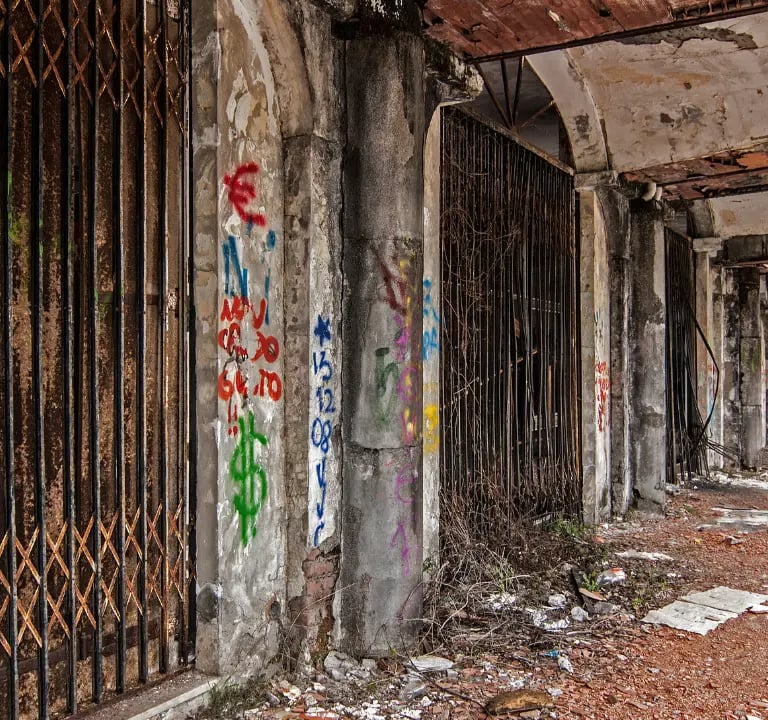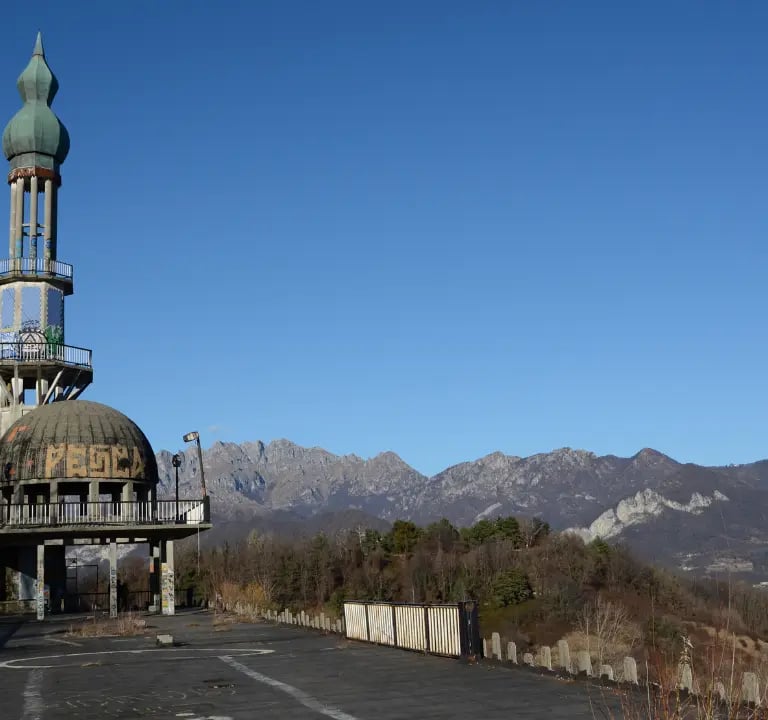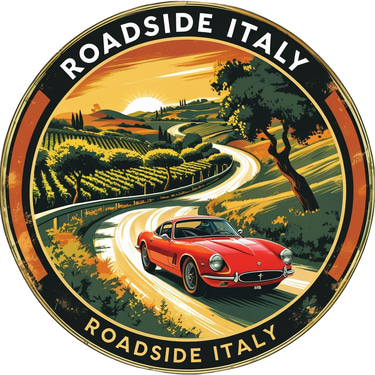Consonno Ghost Town – Explore the Abandoned “Las Vegas of Lombardy”
Discover Consonno, a surreal abandoned village near Lecco once known as the “Las Vegas of Lombardy.” Explore its eerie ruins, colorful graffiti, and haunting history of a 1960s dream gone wrong. A must-see hidden gem for urban explorers in northern Italy.
LOMBARDIA




Few things in Italy feel as bizarrely poetic as standing beneath a crumbling Arabic dome in the middle of Lombardy's green hills, surrounded by cherry blossoms growing through cracked casino floors, while reading a faded sign that still promises eternal celebration. This isn't some ancient Roman ruin or medieval castle — it's the skeletal remains of one man's delirious dream to build Las Vegas in the Italian countryside.
And the strangest part? He almost succeeded.
Drive about an hour northeast of Milan, climb through winding roads lined with chestnut trees, and you'll reach a place that feels almost impossible. Consonno, perched in the green hills of Lombardy, looks like a movie set after everyone's gone home — a faded sign reads "The City of Toys", standing above empty arcades, cracked fountains, and the skeletal remains of a miniature Las Vegas that never quite came to life.
This is Consonno Ghost Town, one of the most surreal and haunting destinations in northern Italy. What was once a millionaire's dream to turn a quiet medieval hamlet into a playground of neon lights and casinos is now a playground for photographers, urban explorers, and anyone fascinated by the poetry of decay.
From Medieval Hamlet to Italian Las Vegas
The Visionary Behind the Dream
In the early 1960s, entrepreneur Count Mario Bagno — a flamboyant Milanese construction magnate — bought the small village of Consonno. He had a bold idea: transform it into "the Las Vegas of Italy."
He demolished most of the original stone houses, sparing only the small church, and began building an over-the-top fantasy city. The place soon filled with Arabic domes, Chinese pagodas, Western-style saloons, and even a miniature castle — a blend of kitsch and grandeur that mirrored the optimism of post-war Italy.
At night, lights flashed, music echoed from the dance halls, and stylish Milanese crowds drove up the hill to drink champagne and dream of fortune. Bagno promised "everything except the sea" — and for a few years, he delivered.
The Fall — When the Dream Collapsed
The glittering vision didn't last. In 1976, a massive landslide destroyed the only road connecting Consonno to the valley below, cutting off access overnight. Visitors stopped coming, businesses closed, and the once-vibrant resort turned silent.
Count Bagno tried to rebuild, but nature and bureaucracy had other plans. Slowly, the fantasy faded into dust. By the 1980s, the neon signs were gone, the buildings abandoned, and silence took over what was meant to be a place of endless celebration.
What remains today is a surreal mix of fairground ruins, graffiti art, and nature reclaiming concrete — ivy climbing over faded frescoes, grass sprouting through old dance floors. The silence is deep but oddly comforting, as if Consonno itself is dreaming of its former glory.
Walking Through the Ghost of Las Vegas
Exploring Consonno feels like walking through a movie scene that's paused in time.
The first thing you see is the arched entrance, still carrying Bagno's words: "Consonno is always in celebration!" Beyond it lie crumbling shops and arcades, a toy train frozen in rust, and the famous Arab dome, now covered in graffiti and surrounded by wildflowers.
In spring, cherry blossoms bloom around broken statues — the contrast between decay and life is breathtaking. You can still spot traces of the old disco, mini racetrack, and even the small zoo Bagno once planned.
Photographers love the mix of nostalgia and dystopia; filmmakers often use it for post-apocalyptic scenes. But what surprises most visitors is the silence — deep, thick, and strangely peaceful.
Not Everyone Knows
The name "Consonno" likely comes from the Latin Consoneus, meaning "harmonious" — an ironic twist for such a chaotic creation.
Bagno originally planned to add a golf course, racetrack, and luxury hotels, but most were never finished.
The church of San Maurizio, built in the Middle Ages, is the only original structure still standing.
Despite being a ghost town, Consonno still hosts occasional music festivals and art events, attracting urban explorers and nostalgia seekers.
Local legend says that Count Bagno returned to Consonno regularly in his old age, wandering among his ruins in silence. He died in 1995, leaving behind both a dream and a warning.
Visiting Consonno Today
Consonno lies within the municipality of Olginate, about an hour's drive from Milan or Lecco. There's no public transport that reaches directly, so a car is essential. The last stretch of road is narrow and winding — drive carefully.
While access is generally open, some buildings are structurally unsafe. Visitors are encouraged to stay outside of unstable areas and respect posted safety signs. Bring water, good shoes, and if possible, a camera — the place is pure visual poetry.
A Symbol of Italian Imagination and Excess
The story of Consonno ghost town captures something deeply Italian — the mix of ambition, creativity, and tragedy that defines so many of the country's hidden stories. It's both absurd and poetic: a monument to dreams that grew too fast and crumbled under their own weight.
Standing in the shadow of its domes, you can almost hear the echoes of laughter and the soft hum of a jukebox. It's easy to see why travelers seeking off beaten path Italy experiences come here — not for the glamour, but for the melancholy beauty that only time can create.
In a region filled with beautiful cities of Italy, Consonno remains unique: an artificial paradise that never found its audience, and in that failure, became unforgettable.
FAQ
Q1: Where exactly is Consonno located? In the hills above Olginate, near Lecco, Lombardy — about 55 km northeast of Milan.
Q2: Is it legal to visit? Yes, visitors are welcome during daytime hours, though certain areas are fenced off for safety. Always respect the signs.
Q3: Can I photograph the buildings? Absolutely. It's a favorite destination for photographers, but drone use may require permission from the municipality.
Q4: Are there tours or guides? There are occasional guided tours organized by local cultural groups and urban exploration associations. Check local Facebook groups for upcoming events.
Q5: Is there anywhere to eat nearby? No active restaurants inside Consonno itself, but plenty of trattorias and farmhouses (agriturismi) in Olginate and Galbiate offer local Lombard cuisine — think risotto, cured meats, and homemade red wine.
